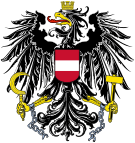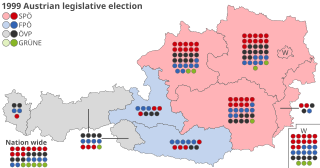
Parliamentary elections were held in Austria on 3 October 1999. Although the Social Democratic Party remained the largest party in the National Council, a right-wing coalition government was formed by the Freedom Party of Austria (FPÖ) and the Austrian People's Party (ÖVP) after several months of negotiations. Although the FPÖ had finished a fraction of a point ahead of the ÖVP in the popular vote, ÖVP leader Wolfgang Schüssel became Chancellor rather than controversial FPÖ leader Jörg Haider. Haider, who had also been elected Landeshauptmann of Carinthia, was not appointed to the cabinet and resigned as party leader.

The Landbund was an Austrian political party during the period of the First Republic (1918–1934).
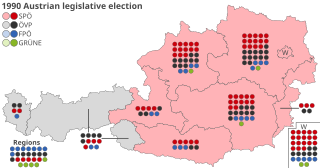
Parliamentary elections were held in Austria on 7 October 1990. The Social Democratic Party won the most seats, and retained the grand coalition with the Austrian People's Party. Voter turnout was 86%.
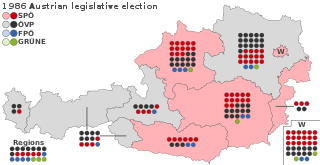
Early parliamentary elections were held in Austria on 23 November 1986. They were called by Chancellor Franz Vranitzky of the Socialist Party (SPÖ), as he was not prepared to continue the coalition government with new Freedom Party (FPÖ) leader Jörg Haider, who had ousted Norbert Steger at the party convention.

Parliamentary elections were held in Austria on 24 April 1983. The result was a victory for the Socialist Party, which won 90 of the 183 seats. However, the Socialists lost the outright majority they had held since 1971, prompting Bruno Kreisky to stand down as SPÖ leader and Chancellor in favour of Fred Sinowatz. The SPÖ stayed in office by entering into a coalition government with the Freedom Party of Austria, which at this point was a liberal party. Voter turnout was 93%.

Parliamentary elections were held in Austria on 6 May 1979. The Socialist Party won a fourth term in government, taking 95 of the 183 seats. Voter turnout was 92.2%. As of the 2017 elections, this is the most seats that an Austrian party has won in a free election, as well as the last time that an Austrian party has won an outright majority.

Parliamentary elections were held in Austria on 5 October 1975. The result was a victory for the Socialist Party (SPÖ), which won 93 of the 183 seats. Voter turnout was 93%.

Early parliamentary elections were held in Austria on 10 October 1971, following electoral reforms intended to benefit smaller parties. The number of seats in the National Council was increased from 165 to 183, and the proportionality of the seat distribution was increased as well.

Parliamentary elections were held in Austria on 1 March 1970. The Socialist Party (SPÖ) emerged as the largest party in the National Council, winning 81 of the 165 seats, just three seats short of an absolute majority and the first time it had become the largest party during the Second Republic. Voter turnout was 92%.

Parliamentary elections were held in Austria on 6 March 1966. The result was a victory for the Austrian People's Party (ÖVP), which won 85 of the 165 seats. Voter turnout was 94%.

Parliamentary elections were held in Austria on 10 May 1959. Although the Socialist Party (SPÖ) received the most votes, the Austrian People's Party won one more seat than the SPÖ. The Communist Party of Austria lost its remaining three seats and has not returned to the National Council since. Voter turnout was 94%. The grand coalition that had governed the country since 1945 remained in office, with People's Party leader Julius Raab as chancellor and Socialist leader Bruno Pittermann as vice-chancellor.
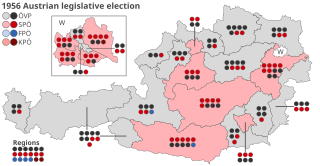
Parliamentary elections were held in Austria on 13 May 1956. The result was a victory for the Austrian People's Party, which won 82 of the 165 seats in the National Council. Voter turnout was 96%. Although the ÖVP had come up one seat short of an absolute majority, ÖVP leader and Chancellor Julius Raab retained the grand coalition with the Socialists, with the SPÖ leader Adolf Schärf as Vice-Chancellor.

Parliamentary elections were held in Austria on 22 February 1953. They were the elections in which the Socialist Party received the most votes since 1920. However, the Austrian People's Party won the most seats. The grand coalition between the two parties was continued with Julius Raab replacing Leopold Figl as Chancellor of Austria, who had had to resign after facing criticism from his own party, and Adolf Schärf of the Socialist Party remaining Vice Chancellor.

Parliamentary elections were held in Austria on 9 October 1949. About 500,000 registered Nazis, who were not allowed to vote in 1945, regained their voting rights. A newly created party, the Electoral Party of Independents (WdU) specifically targeted this group of voters and immediately won a large share of votes. The Austrian People's Party remained strongest party, although losing their absolute majority of seats. Leopold Figl stayed as Chancellor, leading a coalition with the Socialist Party of Austria as junior partner.

Parliamentary elections were held in Austria on 25 November 1945, the first after World War II. The elections were held according to the Austrian election law of 1929, with all citizens at least 21 years old eligible to vote, however former Nazis were banned from voting, official sources putting their numbers at around 200,000.
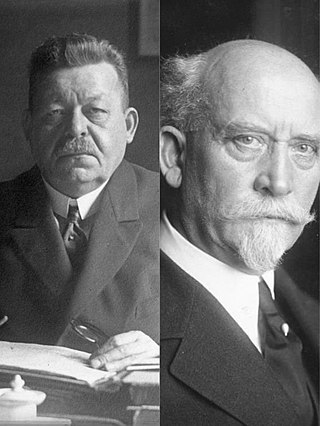
Federal elections were held in Germany on 19 January 1919, although members of the standing army in the east did not vote until 2 February. The elections were the first of the new Weimar Republic, which had been established after World War I and the Revolution of 1918–19, and the first with women's suffrage. The previous constituencies, which heavily overrepresented rural areas, were scrapped, and the elections held using a form of proportional representation. The voting age was also lowered from 25 to 20. Austrian citizens living in Germany were allowed to vote, with German citizens living in Austria being allowed to vote in the February 1919 Constitutional Assembly elections.

Federal elections were held in Germany on 15 June 1893. Despite the Social Democratic Party (SPD) receiving a plurality of votes, the Centre Party remained the largest party in the Reichstag after winning 96 of the 397 seats, whilst the SPD won just 44. Voter turnout was 72.4%.

Legislative elections were held in Cisleithania, the northern and western ("Austrian") crown lands of Austria-Hungary, on 14 and 23 May 1907 to elect the members of the 11th Imperial Council. They were the first elections held under universal male suffrage, after an electoral reform abolishing tax paying requirements for voters had been adopted by the Council and was endorsed by Emperor Franz Joseph earlier in the year. However, seat allocations were based on tax revenues from the States.

Legislative elections to elect members of the Imperial Council were held in Cisleithania, the Austrian section of Austria-Hungary over several days in June and July 1911. A coalition of German national and liberal parties, the Deutscher Nationalverband, emerged as the largest bloc in Parliament, holding 100 of the 516 seats. Voter turnout was 80.2%.

Parliamentary elections were held in Austria on 9 November 1930. The Social Democratic Workers' Party emerged as the largest faction in the National Council, with 72 of the 165 seats, but the Christian Social Party formed a new coalition government with Otto Ender as Chancellor. Voter turnout was 90%.

